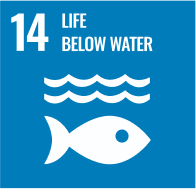14.1 Reduce marine pollution
Target description
The indicators that assess the impact of these actions by Madrid Nuevo Norte were prepared based on the 169 targets associated with the Sustainable Development Goals (SDGs) and the targets taken on by the Madrid City Council and localised for the city.
-

14.1 By 2025, prevent and significantly reduce marine pollution of all kinds, in particular from land-based activities, including marine debris and nutrient pollution.
Operational indicator
Reduction of the pollutant load of the discharge from the Valdebebas WWRP.
The existing capacity of Madrid's wastewater treatment system could not handle the new wastewater flows proposed in Madrid Nuevo Norte in the area located in the basin of the Valdebebas WWTP, which was designed to treat a flow of 0.6 m3/s to comply with the discharge limits in areas not sensitive to eutrophication, and, in addition, because of draught problems in the sludge treatment facilities, it can only treat 0.36 m3/s, without biological treatment to reduce the concentration of nitrogen and phosphorus. For this reason, the entire Jarama basin is currently a sensitive area, especially the water body ES030MSPF0420021 (Jarama River from the Valdebebas stream to the Henares river) which is affected by treatment plant, so it must undergo a comprehensive overhaul to condition it to comply with the new situation.
The existing capacity of Madrid's wastewater treatment system would be unable to handle the new waste water flows proposed in the SMCP for the urban development operation or “Madrid Nuevo Norte” in the area located in the basin of the Valdebebas WWTP.
The Valdebebas WWRP was designed to treat a flow of 0.6 m3/s to comply with the discharge limits in areas not sensitive to eutrophication. Because of draught problems in the sludge treatment facilities, it can only treat 0.36 m3/s, without biological treatment to reduce the concentration of nitrogen and phosphorus.
The entire Jarama basin is currently a sensit ive area, especially the water body ES030MSPF0420021 (Jarama River from the Valdebebas stream to the Henares River) which is affected by treatment plant, so it must undergo a comprehensive overhaul to condition it to comply with the new situation.
Upgrading of the facilities and treatments of the Valdebebas WWRP so that discharges comply with the requirements established for nitrate - vulnerable areas:

The design flows increase, and the maximum loads of the effluents decrease.
Other related impact indicators
Indicators prepared based on sources such as the United Nations, the Spanish Statistical Office, the European Commission and the Madrid City Council.
-
Indicator for Coastal Eutrophication Potential (ICEP): 2,247 km2 (0.13%) (Portugal) (2020).
Specific methodology
Learn more about the specific methodology, reference sources and indicators used for this target.
Download methodology
